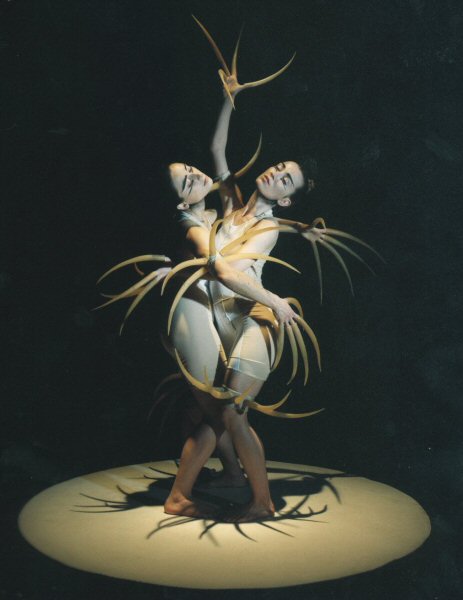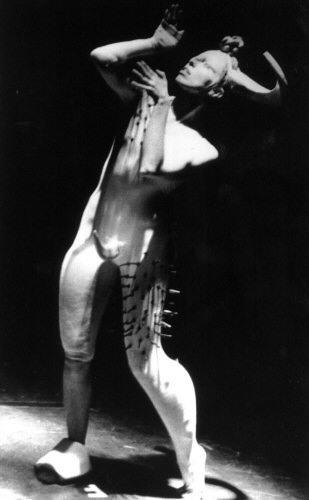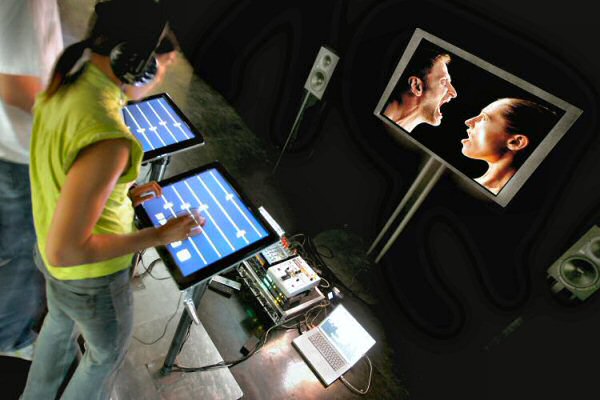Please wait a few moments while we process your request

Marie Chouinard
(Montreal, Quebec, Canada)
Marie Chouinard is a choreographer, dancer, performer, and occasional set, costume, sound and light designer. She has worked since 1978 in building a diverse choreographic corpus that has earned her a place in the contemporary dance and art scene. In 1990, after 12 years as a solo artist performing throughout the world, she founded the Compagnie Marie Chouinard, dedicating herself primarily to creating group work. Her most recent creation, Le Cri du Monde (2000), is touring Europe. Also on tour is Les Solos 1978-1998, a recent retrospective of her work co-produced by her company with the Musée d'art contemporain de Montréal and the National Arts Centre in Ottawa.
On local, national and international contemporary dance scenes, Marie Chouinard has been known to stir both the minds and bodies of critics and the public. Beginning with her first solo creation in 1978 called Cristallisation, in collaboration with artist Rober Racine, Chouinard has continually pushed the boundaries of on-stage performance and riveted her audience with pieces such as Mimas, Lune de Saturne (1980) and the notorious Marie Chien Noir (1982), which was criticized for its lengthy masturbation scene. In this piece, Chouinard’s soft guttural utterings are highlighted as she performs intimate rituals for her audience. Rober Racine writes of Marie Chien Noir:
"This piece is a world of pure participation, a place that is both private and privileged. A full acceptance of the work’s purpose gives deeper meaning to its attendant images. And it’s such an anti-rational upheaval of sung, chanted, shouted words that it establishes an immediate, palpable, entirely natural relationship with its audience." (1)
Chouinard continued her solo career throughout the 1980s, performing internationally, and prolifically choreographing new work. Among several creations, she produced Crue in 1986 and the acclaimed L’Après-midi d’un faune in 1987. Over these two years, she was awarded two prestigious prizes in Canada: the Jacqueline Lemieux Prize from the Canada Council for the Arts (1986) and a Jean A. Chalmers Award (1987). Throughout this period, Chouinard explored many other avenues of artistic expression including performance art, video, installation, film and vocal work.(2)
The 1990s were a new period for Chouinard, as she decided to form her own dance company after seeing a vision of many dancers in her head while working on a new solo. (3) In 1990, the Compagnie Marie Chouinard was born, and from that point on, Chouinard began assuming the role of artistic director rather than star of her own choreographed performances. The company has produced several highly praised pieces, some of which are still touring today. Works such as Le Sacre du printemps (1993), Prélude à l’après-midi d’un faune (1994), L’Amande et le Diamant (1996) and Les 24 préludes de Chopin (1999) all garnered much attention for their originality and sensuality. About L’Amande et le Diamant, one critic in The Globe and Mail writes, "By turns naughty, childish, sophisticated and brazen, L’Amande et le Diamant succeeds as a brilliantly self-contained work of unparalleled imagination." (4)
In 2000, Chouinard premiered a new work, Le Cri du Monde (2000). With an electronic score composed by Louis Dufort, this new piece focuses mainly on the body, both visually and kinetically. Says Chouinard:
"On a formal level it’s about all the articulations of the body, restructured to create new openings, new avenues for sensations. It’s also about the energy created, in the sudden emergence of beauty, about violence in beauty and so much beauty in violence and the paradox of life that beauty and violence can occur together." (5)
This piece has been presented in 2001 around the globe at venues and festivals such as the Venice Biennale (Venice, Italy), the Festival Julidans (Amsterdam, the Netherlands) and the Festival international de nouvelle danse (Montreal, Quebec).
Chouinard has also created her first major work exploring digital technologies. She has employed technology in previous pieces but has never made it an integral part of the performance. For example, "for L’Après-midi d’un faune (1987) she [Chouinard] created the score as she danced, with synthesizer controls connected to various points of her body. She was amused to discover how few cottoned on to what she was doing." (6)
This new piece, titled Cantique : cycle 1, explores music and movement mediated through software for real-time manipulation of sound and video. Chouinard offers her insight into the use of new technologies in performance.
On local, national and international contemporary dance scenes, Marie Chouinard has been known to stir both the minds and bodies of critics and the public. Beginning with her first solo creation in 1978 called Cristallisation, in collaboration with artist Rober Racine, Chouinard has continually pushed the boundaries of on-stage performance and riveted her audience with pieces such as Mimas, Lune de Saturne (1980) and the notorious Marie Chien Noir (1982), which was criticized for its lengthy masturbation scene. In this piece, Chouinard’s soft guttural utterings are highlighted as she performs intimate rituals for her audience. Rober Racine writes of Marie Chien Noir:
"This piece is a world of pure participation, a place that is both private and privileged. A full acceptance of the work’s purpose gives deeper meaning to its attendant images. And it’s such an anti-rational upheaval of sung, chanted, shouted words that it establishes an immediate, palpable, entirely natural relationship with its audience." (1)
Chouinard continued her solo career throughout the 1980s, performing internationally, and prolifically choreographing new work. Among several creations, she produced Crue in 1986 and the acclaimed L’Après-midi d’un faune in 1987. Over these two years, she was awarded two prestigious prizes in Canada: the Jacqueline Lemieux Prize from the Canada Council for the Arts (1986) and a Jean A. Chalmers Award (1987). Throughout this period, Chouinard explored many other avenues of artistic expression including performance art, video, installation, film and vocal work.(2)
The 1990s were a new period for Chouinard, as she decided to form her own dance company after seeing a vision of many dancers in her head while working on a new solo. (3) In 1990, the Compagnie Marie Chouinard was born, and from that point on, Chouinard began assuming the role of artistic director rather than star of her own choreographed performances. The company has produced several highly praised pieces, some of which are still touring today. Works such as Le Sacre du printemps (1993), Prélude à l’après-midi d’un faune (1994), L’Amande et le Diamant (1996) and Les 24 préludes de Chopin (1999) all garnered much attention for their originality and sensuality. About L’Amande et le Diamant, one critic in The Globe and Mail writes, "By turns naughty, childish, sophisticated and brazen, L’Amande et le Diamant succeeds as a brilliantly self-contained work of unparalleled imagination." (4)
In 2000, Chouinard premiered a new work, Le Cri du Monde (2000). With an electronic score composed by Louis Dufort, this new piece focuses mainly on the body, both visually and kinetically. Says Chouinard:
"On a formal level it’s about all the articulations of the body, restructured to create new openings, new avenues for sensations. It’s also about the energy created, in the sudden emergence of beauty, about violence in beauty and so much beauty in violence and the paradox of life that beauty and violence can occur together." (5)
This piece has been presented in 2001 around the globe at venues and festivals such as the Venice Biennale (Venice, Italy), the Festival Julidans (Amsterdam, the Netherlands) and the Festival international de nouvelle danse (Montreal, Quebec).
Chouinard has also created her first major work exploring digital technologies. She has employed technology in previous pieces but has never made it an integral part of the performance. For example, "for L’Après-midi d’un faune (1987) she [Chouinard] created the score as she danced, with synthesizer controls connected to various points of her body. She was amused to discover how few cottoned on to what she was doing." (6)
This new piece, titled Cantique : cycle 1, explores music and movement mediated through software for real-time manipulation of sound and video. Chouinard offers her insight into the use of new technologies in performance.
Angela Plohman © 2001 FDL
(1) Rober Racine, "Marie Chien Noir de Marie Chouinard: l’étoilement de l’amour," ArtsCanada (November 1982), 33-36.
(2) Chouinard’s biography : http://www.mariechouinard.com
(3) See Robert Everett-Green, "Face to Face: Marie Chouinard," The Globe and Mail (31 October 1992) C1-C2: C2.
(4) Deirdre Kelly, "Carnal caper electrifies dance crowd," The Globe and Mail (June 10, 1996): I15.
(5) Marie Chouinard quoted in Susan Walker, "Choreographer feels life's rhythms through dance," The Toronto Star (March 19, 2000): n.p.n.
(6) Robert Everett-Green C2.
Related page:
 Marie Chouinard, Cantique n° 1
Marie Chouinard, Cantique n° 1In Cantique n° 1, Marie Chouinard explores the relationship between movement and sound, with the help of a uniquely designed computer program and real-time interaction between musicians.
External links:
Venice Biennale :
http://www.labiennale.org
http://www.labiennale.org
Festival Julidans :
http://www.julidans.com
http://www.julidans.com
Compagnie Marie Chouinard:
http://www.mariechouinard.com
http://www.mariechouinard.com









